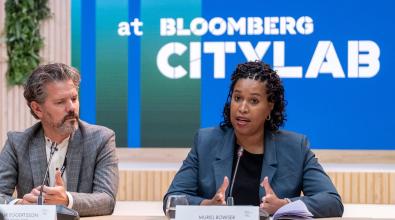5 things mayors should consider during COVID’s next phase

Almost three months into the COVID-19 pandemic, the news sometimes seems headed in completely opposite directions.
The United States surpassed 100,000 confirmed deaths due to the coronavirus this week, and new hotspots of infection were reported in Alabama, North Carolina, Minnesota, and other states. At the same time, the numbers of new cases and deaths nationally continue to decline gradually, and a growing number of cities are now in some stage of reopening.
Where should mayors be focused in this somewhat muddled moment? That was an issue addressed by John Hopkins University’s Josh Sharfstein, who spoke yesterday with hundreds of local leaders gathered for an online coaching and learning session of the COVID-19 Local Response Initiative. Sharfstein said there are five things mayors can do as they focus on the road ahead:
1. Keep following the data on the pandemic. Mayors will need to continue keeping a watchful eye on all the vital statistics they’ve become familiar with, such as the percentage of tests that come back positive and the number of hospitalizations, Sharfstein said. Those numbers will indicate whether restrictions can be lifted when things are going well or need to be put back into place if they’re not. To support decision making and help with communicating with the public, Sharfstein said cities may want to adopt an alert-level system with codes red, orange, yellow, and green, along the lines of what the public health experts at Resolve to Save Lives are promoting.
[Get the City Hall Coronavirus Daily Update. Subscribe here.]
2. Communicate with clarity and empathy. Communication with the public will continue to be a critical role for mayors in the weeks and months ahead. “Communication is more than just telling people what’s going on,” Sharfstein said. “It’s actually part of the public health response. It’s how people know what to do to take care of themselves and to protect the people that they care about in their lives.” He added: “Credibility remains the single most important aspect of crisis communication. If you don’t have credibility, people won’t believe you. So it’s really important to be honest, to admit mistakes and move past them, and to be seen as a source of truth.”
3. Pursue multiple strategies to end racial and ethnic disparities. The pandemic has exposed many inequities in healthcare, and there are numerous things mayors can do to address them. One way is to make sure all frontline workers — not just first responders and healthcare workers, but anybody who is out engaging with people in their jobs — have appropriate protective gear. City leaders also can push to make testing more widely available, partner with community leaders who have credibility in affected neighborhoods to do outreach, and address basic needs like food insecurity.
4. Look for opportunities to address COVID — plus other issues. Sharfstein challenged mayors to find ways to make their efforts against the coronavirus count in the fight against other problems at the same time. For example: Could the push cities are making around delivering food to people be leveraged to more regularly improve residents’ access to healthy foods? Sharfstein pointed to housing shortages, violence prevention, and drug addiction as other opportunities. “The rules for addiction treatment have changed — medicine for opioid addiction can now be prescribed over the phone without an in-person visit,” Sharfstein said. “That opens the door to some great collaborations between your treatment programs and your community-based programs to get people life-saving treatment much faster than previously was possible before the pandemic.”
5. Develop a stronger public-health system for the future. While mayors are still in emergency-response mode, it’s not too early to begin thinking about how today’s decisions can build public-health capacity for the long run, Sharfstein said. For example, the small armies of people that cities, counties, and states are building to do coronavirus contact-tracing could someday be repurposed to address other pressing issues of health and equity. “When we have a vaccine, rather than just firing all the contact tracers and going back to the ways we were doing things before, mayors can use this workforce to address longstanding challenges,” Sharfstein said.
